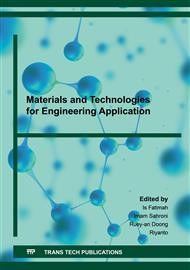[1]
D. Kathryn M., and Charles F. Kulpa Jr. Toxicity and antimicrobial activity of imidazolium and pyridinium ionic liquids. Green Chemistry 7 (2005) 185-189.
DOI: 10.1039/b419172b
Google Scholar
[2]
D. Jairton. On the solid, liquid and solution structural organization of imidazolium ionic liquids. Journal of the Brazilian Chem. Soc. 15 (2004) 341-350.
DOI: 10.1590/s0103-50532004000300002
Google Scholar
[3]
G. Florence JV, et al. Ultra-low cost ionic liquids for the delignification of biomass. Ionic Liquids: Current State and Future Directions. American Chem. Soc. (2017) 209-223.
DOI: 10.1021/bk-2017-1250.ch009
Google Scholar
[4]
H. Shaoqin, et al. Potential applications of ionic liquids in wood related industries. BioResources 4 (2009) 825-834.
Google Scholar
[5]
J. Andrew, and Nicholas Gathergood. Biodegradation of ionic liquids–a critical review. Chem. Soc. Rev. 44 (2015): 8200-8237.
DOI: 10.1039/c5cs00444f
Google Scholar
[6]
K. Jaberi, Zahed, et al. Triethylammonium Hydrogen Sulfate [Et3NH][HSO4] as an Efficient Ionic Liquid Catalyst for the Synthesis of Coumarin Derivatives. Polycyclic Aromatic Compounds (2017). doi.org/10.1080/10406638.2017.1363061.
DOI: 10.1080/10406638.2017.1363061
Google Scholar
[7]
K. Mariusz, and Grzegorz Kowaluk. Wood hydrophobization by ammonium ionic liquids. Drewno. Prace Naukowe. Doniesienia. Komunikaty 53.184 (2010).
Google Scholar
[8]
M. Hisasi, Application of ionic liquids for effective use of woody biomass. J. Wood Sci. 61 (2015) 343–350.
DOI: 10.1007/s10086-015-1489-4
Google Scholar
[9]
M. Carol Anne, and Neil Andrew Robert Gow. Chitin synthesis in human pathogenic fungi. Medical mycology 39.1 (2001): 41-53.
DOI: 10.1080/mmy.39.1.41.53
Google Scholar
[10]
P. Juliusz, et al. Long alkyl chain quaternary ammonium-based ionic liquids and potential applications. Green Chemistry 8 (2006) 798-806.
Google Scholar
[11]
S. Monika, et al. 1-Alkoxymethyl-X-dimethylaminopyridinium-base ionic liquids in wood preservation. Holzforschung 62 (2008) 309-317.
DOI: 10.1515/hf.2008.028
Google Scholar
[12]
S. I. M., and Adi Santoso. Pengaruh jenis bambu, waktu kempa dan perlakuan pendahuluan bilah bambu terhadap sifat papan bambu lamina. Jurnal Penelitian Hasil Hutan 30 (2012) 199-207.
DOI: 10.20886/jphh.2012.30.3.199-207
Google Scholar
[13]
S. Michael J., and Alan DW Dobson. Mycotoxin production by Aspergillus, Fusarium and Penicillium species. Int. J. food microbiol. 43 (1998) 141-158.
DOI: 10.1016/s0168-1605(98)00112-3
Google Scholar
[14]
W. Thomas. Room-temperature ionic liquids. Solvents for synthesis and catalysis. Chem. rev. 99 (1999) 2071-2084.
DOI: 10.1021/cr980032t
Google Scholar
[15]
W. Elizabeth A., and Karsono Karsono. Bamboo Diversity in Sumba Island. Biodiversitas J. Bio. Diversity 6 (2005).
DOI: 10.13057/biodiv/d060205
Google Scholar
[16]
Z. SM Shahrul Nizan Shikh, Hazeeq Azman, and Latifah Karim. Triethylammonium hydrogen sulfate ionic liquid as a low-cost solvent: A short review of synthesis, analysis and applications. MATEC Web of Conferences. Vol. 204. EDP Sciences, 2018. doi.org/10.1051/matecconf/201820400006.
DOI: 10.1051/matecconf/201820400006
Google Scholar


